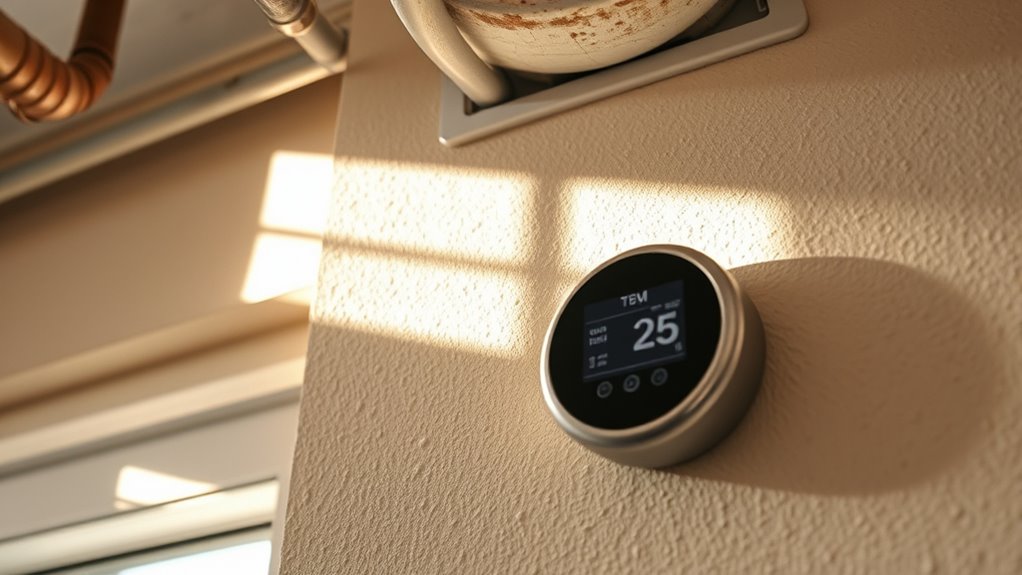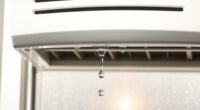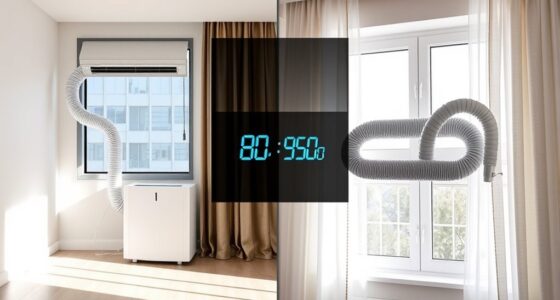Placing your thermostat near drafts, vents, or in direct sunlight can cause it to misread the temperature, making your HVAC work harder and spike your bills. Avoid areas with heat sources like radiators or reflective surfaces that reflect heat and throw off readings. Also, steer clear of common blind spots or faulty wiring, which can lead to inconsistent operation. Want to find out how to optimize your thermostat’s placement? Keep going to learn more.
Key Takeaways
- Placing the thermostat near drafts, vents, or windows causes inaccurate readings, leading to inefficient HVAC operation and higher energy bills.
- Positioning the thermostat in direct sunlight or heat sources skews temperature readings, prompting unnecessary HVAC activity.
- Ignoring common placement errors and wiring issues can result in inconsistent signals and increased energy consumption.
- Incorrect thermostat placement causes the system to run longer or shorter than needed, raising electricity costs.
- Failing to consider environmental factors like drafts or heat sources reduces accuracy, causing costly energy waste.
Placing the Thermostat Near Drafts and Vents
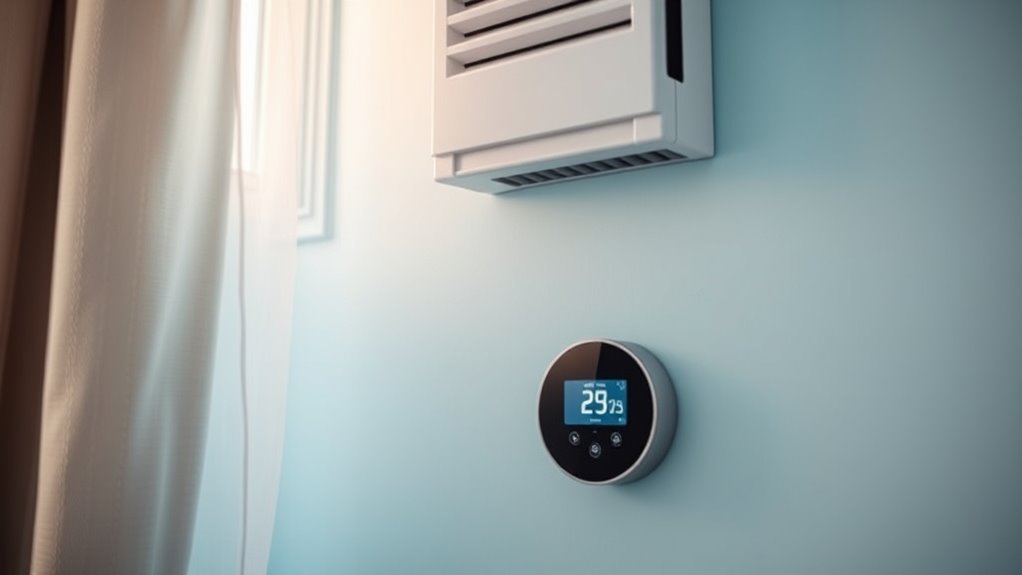
Placing your thermostat near drafts or vents can cause inaccurate temperature readings and lead to inefficient heating or cooling. When drafts or strong air currents hit the thermostat, it may register a cooler or warmer temperature than the actual room temperature, disrupting proper thermostat calibration. This misreading causes your HVAC system to run longer or shorter than necessary, increasing energy bills. Additionally, wiring issues can compound the problem if the thermostat’s connections are loose or faulty, leading to inconsistent signals and further calibration errors. To avoid these issues, keep your thermostat away from vents, windows, or drafty areas. Proper placement ensures accurate readings, ideal thermostat calibration, and reliable operation, helping you save on energy costs and maintain comfortable indoor temperatures. Regular maintenance and sensor placement are crucial for optimal performance and energy efficiency.
Positioning the Thermostat in Direct Sunlight or Heat Sources
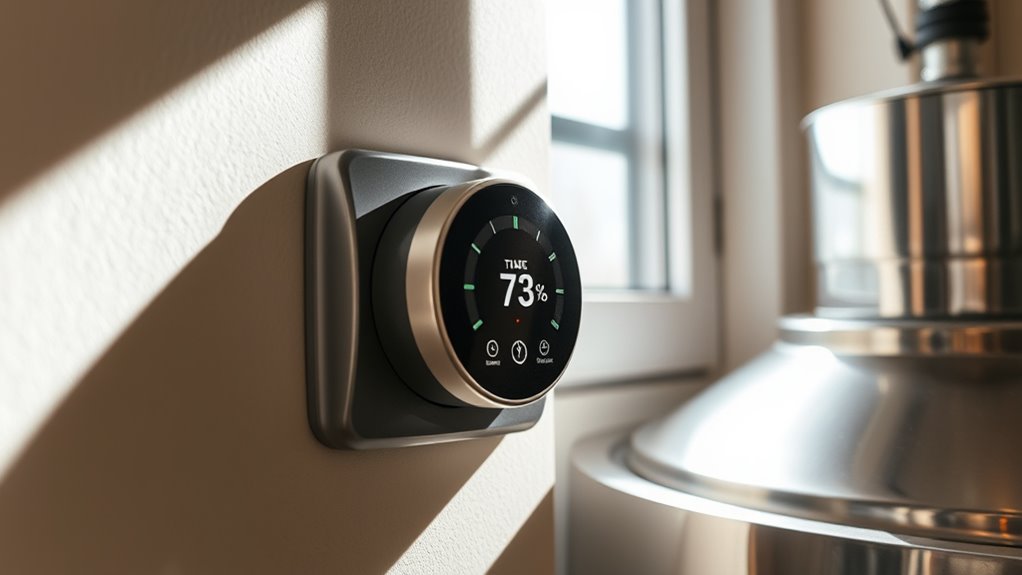
Positioning your thermostat in direct sunlight or near heat sources can cause it to read higher temperatures than the actual room temperature. Solar gain from sunlight hitting the thermostat can trick it into thinking the room is warmer, prompting your system to cool unnecessarily. Similarly, thermal reflection from nearby surfaces like glass or metal can skew readings, making the thermostat register false warmth. This misreading leads to increased energy use, as your HVAC system works harder than needed. To prevent this, place your thermostat away from windows, direct sunlight, radiators, or appliances that emit heat. Ensuring accurate readings helps your system operate efficiently, keeping your bills in check and maintaining a comfortable home environment. Additionally, understanding environmental considerations helps you select the best location for your thermostat, avoiding areas that could cause inaccurate readings.
Ignoring Common Blind Spots and Obvious Placement Errors
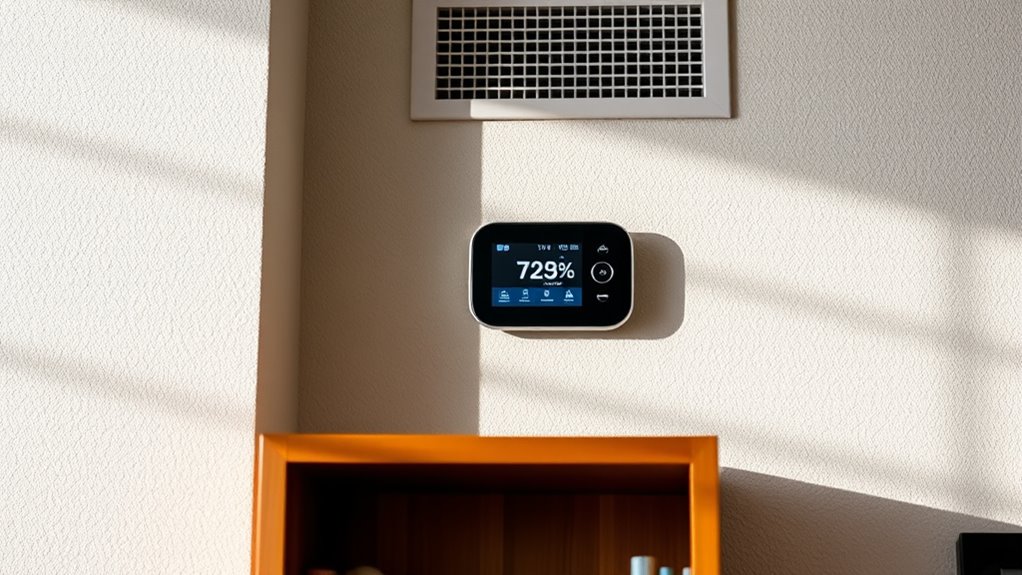
Many homeowners overlook common blind spots and obvious placement errors that can throw off thermostat readings. For example, wiring issues or sensor calibration problems often go unnoticed, leading to inaccurate temperature readings. If your thermostat’s wiring is loose or damaged, it can cause inconsistent signals, making your system work harder and spike bills. Similarly, ignoring the sensor calibration—assuming it’s correct without testing—can result in the thermostat misreading room conditions. Keep sensors away from drafts, vents, or appliances that generate heat or cold, and ensure wiring connections are secure. These simple checks prevent errors that cause your HVAC system to cycle unnecessarily, helping you maintain a consistent indoor temperature and avoid costly energy waste. Additionally, staying informed about advancements in AI technology can help homeowners utilize smart thermostats that automatically optimize settings for energy efficiency.
Frequently Asked Questions
Can Thermostat Placement Affect Heating and Cooling Efficiency?
Yes, thermostat placement can markedly impact heating and cooling efficiency. If you position your smart thermostat in a spot with drafts, direct sunlight, or near heat sources, it’ll give inaccurate readings, causing unnecessary energy use. Using zoning strategies and placing your thermostat in a central, stable location helps maintain consistent temperatures, saving you money. Correct placement ensures your smart thermostat works effectively, optimizing your HVAC system’s performance and reducing your bills.
How Does Thermostat Placement Influence Energy Consumption?
Imagine your thermostat as the heartbeat of your home’s climate—you control energy use. If it’s poorly placed, it struggles to accurately sense temperature, leading to overuse of heating or cooling. This not only spikes your bills but also hampers humidity control and air quality. Proper placement guarantees your system responds efficiently, maintaining comfort without wasting energy, and keeps your home healthier and more balanced.
What Are Signs of Incorrect Thermostat Positioning?
If your thermostat isn’t correctly positioned, you might notice inconsistent temperature readings or frequent system cycling. Signs include incorrect thermostat calibration, causing it to misjudge the room’s actual temperature, or wiring issues that lead to inaccurate signals. You may also experience difficulty in controlling your home’s climate, resulting in higher energy bills. Check the placement to guarantee it’s away from drafts, heat sources, and direct sunlight for ideal performance.
Are There Specific Rooms Where Thermostat Placement Is More Critical?
Ironically, some rooms demand more attention for thermostat placement than others. You should prioritize rooms with room-specific placement and make certain the temperature sensor location isn’t near windows, vents, or direct sunlight. Bedrooms and living rooms are essential because they’re used most often, so placing the thermostat carefully in these areas helps maintain a consistent temperature, preventing your bills from skyrocketing due to inaccurate readings or uneven heating.
How Can I Test if My Thermostat Is Correctly Positioned?
To test if your smart thermostat is correctly positioned, start by manually adjusting it and observing how your home responds. Check if it accurately reads the temperature in the main living areas; if not, consider relocating it. Use your smart thermostat’s app to monitor temperature consistency. If necessary, reposition the thermostat to a central, draft-free spot, ensuring it reflects the true room temperature, which helps optimize comfort and energy savings.
Conclusion
You might never realize how a simple mistake, like placing your thermostat near a draft or a sunny window, could be quietly boosting your bills. It’s funny how often we overlook these spots—only to find out later that they’ve been costing us. By paying attention to placement, you could save money without changing your habits. Sometimes, a small tweak in the right spot makes all the difference—just like discovering that hidden draft in your own home.
